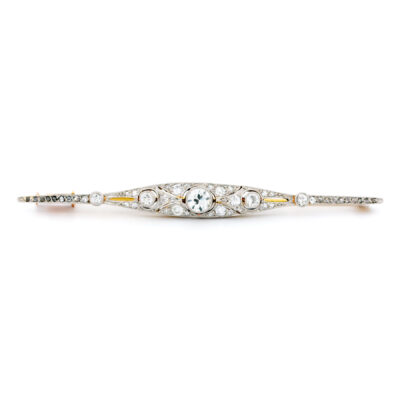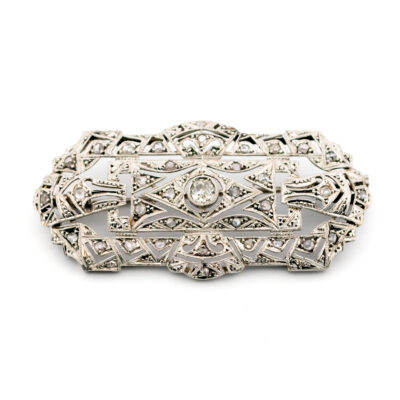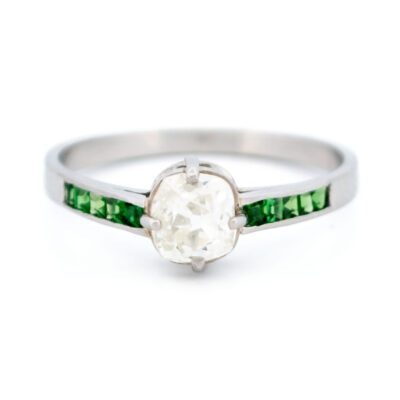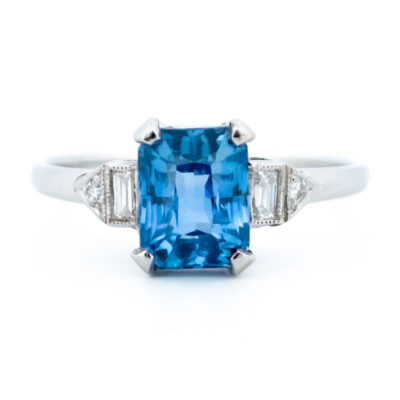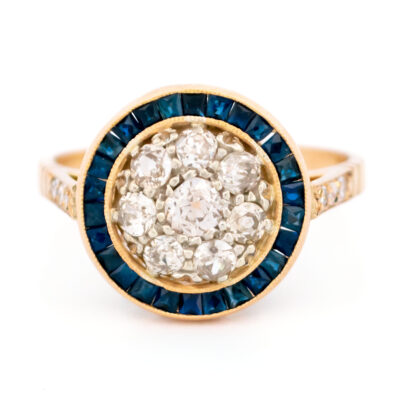You will love this charming vintage ribbon brooch, featuring pearls, iolites and pink garnet in a graceful design. The brooch is made of 14k gold and has a weight of 2.4 grams, making it easy to pin on any garment. It also has the 585 Dutch assay mark, which certifies its quality and provenance. Hallmarks: 585 Dutch assay mark.
Videos
Details: Pearls, Iolites, pink Garnet, 14k Brooch, Hallmarks: 585 Dutch assay mark.
Design Era: Vintage.
Dimensions: LxW: 2.2 x 2.2 cm..
Weight in grams: 2.41.
Condition: Very good condition – slightly used with small signs of wear.
Shipping and Pickup: This stylish piece ships from our store located in the center of Amsterdam, The Netherlands. We offer both registered shipping and local pickup at our store. In the case of local pickup, any applicable shipping costs will be refunded.
About Us: Add some sparkle to your style with Binenbaum.com. We offer a stunning selection of antique and vintage jewelry that you won’t find anywhere else. From timeless rings and dazzling necklaces to unique brooches, we have something for every taste and occasion. Visit our website today and treat yourself to a piece of history.
| Design Era | |
|---|---|
| Design & Historical Context | Vintage jewelry refers to jewelry that was produced a certain number of years ago, typically at least 20 years or more. It is often characterized by its unique style, craftsmanship, and use of materials that are no longer in production or are hard to find. Vintage jewelry can be made from a wide variety of materials, including gold, silver, platinum, and diamonds, as well as less precious materials such as costume jewelry or Bakelite. It can be influenced by a variety of styles and movements, including Art Deco, Art Nouveau, and Retro. One of the key features of vintage jewelry is its uniqueness and individuality. Unlike modern jewelry, which is often mass-produced, vintage jewelry is often one-of-a-kind or part of a limited production run. This makes it highly collectible and sought after by collectors and vintage enthusiasts. Vintage jewelry is often associated with a sense of history and nostalgia, and it can be a way to connect with the past and appreciate the craftsmanship and artistry of earlier periods. It is highly collectible and can be found at vintage stores, antique shops, and online marketplaces. |
| Key Materials | |
| Materials & Craftsmanship | Pearl: The Gem of Elegance and Purity Pearls, with their natural luster and timeless beauty, are one of the most revered gemstones in the world. Unlike other gems, pearls are organic, formed within the soft tissue of mollusks like oysters and mussels. Their formation process results in a smooth, round gem with a soft, iridescent glow, often referred to as the "pearl essence." Historically, pearls have been a symbol of purity, wisdom, and wealth. In ancient Rome, they were considered the ultimate status symbol, while in ancient China, pearls were believed to protect against fire and dragons. During the Renaissance, pearls were so highly valued that they were reserved for royalty and nobility, symbolizing perfection and integrity. In modern jewelry, pearls are cherished for their classic elegance and versatility. They are commonly found in a range of colors, from the traditional white and cream to rare black, pink, and golden hues. Pearls are often strung into necklaces, set into earrings, or used as delicate accents in rings and bracelets. Their softness, with a Mohs hardness of 2.5 to 4.5, requires gentle care, but their beauty and sophistication are unmatched. Pearls are more than just a gem; they are a symbol of grace, purity, and timeless style. Their natural origins and understated elegance make them a beloved choice for jewelry that exudes refinement and sophistication. Iolite (water sapphire): The Gem of Vision and Viking Lore Iolite, also known as "water sapphire," is a striking gemstone known for its deep, violet-blue color and remarkable pleochroism, where the stone displays different colors when viewed from different angles. This unique characteristic gives iolite an almost magical quality, as it can appear blue, violet, or even grayish depending on the light and the angle of view. Historically, iolite has been revered for its beauty and mystical properties. The stone’s name comes from the Greek word "ios," meaning violet. Iolite is often associated with the ancient Vikings, who are said to have used thin slices of iolite as navigational tools. The gemstone, sometimes referred to as the "Viking Compass," helped them determine the position of the sun on cloudy days, guiding them safely across the seas. In modern jewelry, iolite is prized for its rich color and affordability compared to other blue gemstones like sapphire and tanzanite. It is typically cut into faceted stones to enhance its pleochroism and is used in a variety of jewelry pieces, including rings, pendants, earrings, and bracelets. With a Mohs hardness of 7 to 7.5, iolite is durable enough for everyday wear, though it should be protected from harsh impacts and scratches. Iolite’s deep, mysterious hues make it a popular choice for those seeking a gemstone with a unique and captivating appearance. It pairs beautifully with both silver and gold settings, allowing its violet-blue tones to shine. The stone’s connection to vision and navigation also makes it a meaningful choice for those who value intuition and inner guidance. Iolite is more than just a gemstone; it is a symbol of clarity, direction, and inner strength. Its rich history and unique optical properties make it a fascinating and beautiful choice for jewelry that stands out with both elegance and intrigue. Whether chosen for its historical significance or its stunning color, iolite adds a touch of mystique and beauty to any jewelry collection. Garnet: The Stone of Passion and Protection Garnet, renowned for its deep red hue, is a gemstone that symbolizes passion, energy, and protection. Though commonly associated with its rich red color, garnet actually comes in a variety of shades, including green, orange, and even rare blue, making it a versatile and intriguing gemstone. Garnet has a long history of use, dating back to ancient Egypt, where it was worn by pharaohs as a symbol of life and power. In Roman times, garnets were often set into signet rings used to stamp wax seals on important documents. The stone was also believed to offer protection to travelers and warriors, warding off harm and ensuring safe journeys. In jewelry, garnet’s durability, with a Mohs hardness of 6.5 to 7.5, and its striking color make it a popular choice for rings, necklaces, and earrings. Its ability to capture and reflect light with a warm, fiery glow adds a touch of drama and sophistication to any piece. Garnet is more than just a gemstone; it is a symbol of enduring passion and strength. Its vibrant energy and historical significance make it a timeless and powerful choice for jewelry that stands out and tells a story. 14k: The Durable Choice for Everyday Elegance 14k gold is a popular and practical choice in fine jewelry, known for its durability, affordability, and beautiful color. The "14k" signifies that the gold is composed of 58.3% pure gold and 41.7% alloyed metals, such as copper, silver, nickel, or zinc. This combination results in a strong and resilient material that can withstand the rigors of daily wear, making it an ideal option for those seeking both beauty and durability. Historically, gold has always been a symbol of wealth and luxury, and 14k gold strikes a perfect balance between the rich appearance of gold and the strength needed for everyday use. Because of its lower gold content compared to 18k or 24k gold, 14k gold is more affordable, making it a popular choice for a wide range of jewelry pieces. In modern jewelry, 14k gold is appreciated for its versatility and variety. It is available in several colors, each achieved by mixing gold with different metals: Yellow Gold: A classic and timeless choice, 14k yellow gold has a warm, golden hue that complements most skin tones and is well-suited for both modern and traditional designs. White Gold: Created by alloying gold with white metals like nickel or palladium, 14k white gold has a sleek, silver-like appearance. It is often rhodium-plated for added shine and is a popular choice for engagement rings and other contemporary jewelry. Rose Gold: Achieved by mixing gold with copper, 14k rose gold has a soft, pinkish hue that has gained popularity for its romantic and vintage appeal. It is a favorite for those seeking a unique and stylish alternative to traditional gold colors. 14k gold is commonly used in a wide array of jewelry, including rings, necklaces, bracelets, earrings, and watches. Its durability makes it especially suitable for pieces that are worn daily, such as wedding bands and engagement rings, where the balance between strength and beauty is crucial. 14k gold is more than just a practical choice; it is a symbol of enduring style and everyday luxury. Its ability to retain the look of gold while offering greater resistance to scratches and dents makes 14k gold a versatile and timeless option for any jewelry collection. Whether in a simple band or an elaborate design, 14k gold offers a perfect blend of elegance and durability that can be enjoyed for years to come. |
| Dimensions | LxW: 2.2 x 2.2 cm. |
| Gender | |
| Weight (in grams) | 2.41 |
| Condition | Very good condition – slightly used with small signs of wear |
By following these tips, you can enjoy your precious jewelry for many years to come.
Related Products
-
Garnet Pearl Agate Marcasite (Pyrite) Silver Floral Brooch 13121-1178
€ 395,00 VAT incl. (where applicable) -
Diamond Pearl 14k Platinum Deco Brooch 14922-8422
€ 1.395,00 VAT incl. (where applicable) -
Garnet 14k Love Knot Brooch 14935-8434
€ 995,00 VAT incl. (where applicable) -
Diamond 18k Platinum “Bar” Brooch 16248-8772
€ 2.995,00 VAT incl. (where applicable) -
Enamel Pearl Ruby Silver Butterfly Brooch 16216-2504
€ 245,00 VAT incl. (where applicable) -
Diamond 14k Silver Victorian Brooch 14923-8423
€ 2.695,00 VAT incl. (where applicable) -
Diamond Deco Brooch 14950-2444
€ 2.895,00 VAT incl. (where applicable) -
Garnet Pearl 14k Round-Shape Pendant 14900-8400
€ 895,00 VAT incl. (where applicable)
- Home
- Collection
- Fine Jewelry
- Silver Jewelry
- Silverware
- Boxes
- Candlesticks
- Salt and pepper shakers
- Miniatures
- Salt cellars
- Spoon Set
- Condiments
- Frames
- Napkin Ring
- Spoon
- Oddities
- Cups
- Vases
- Cutlery
- Serving Spoon And Cake Server
- Candlesticks
- Baskets
- Hanukkiah
- Spice Tower
- Yad
- Tea Set
- Sugar Castor
- Napkin Rings
- Wine Bottle Coaster
- Wine Stopper
- Tea Pot
- Jugs
- Rattles
- Hip Flask
- Miscellaneous
- Rings 💍
- About
- Contact
- No products in the cart.











